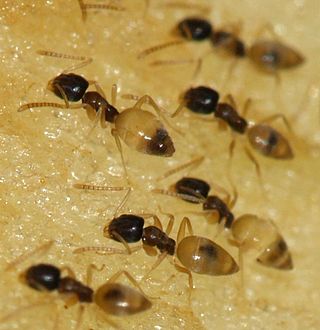
Dolichoderinae is a subfamily of ants, which includes species such as the Argentine ant, the erratic ant, the odorous house ant, and the cone ant. The subfamily presents a great diversity of species throughout the world, distributed in different biogeographic realms, from the Palearctic, Nearctic, Afrotropical region and Malaysia, to the Middle East, Australian, and Neotropical regions.

Tapinoma is a genus of ants that belongs to the subfamily Dolichoderinae. The genus currently comprises 74 described species distributed worldwide in tropical and temperate regions. Members of are generalized foragers, nesting in a wide variety of habitats, ranging from grasslands, open fields, woodlands, to inside buildings. The majority of species nest in the ground under objects such as stones or tree logs, other species build nests under bark of logs and stumps, in plant cavities, insect galls or refuse piles.

Tapinoma melanocephalum is a species of ant that goes by the common name ghost ant. They are recognised by their dark head and pale or translucent legs and gaster (abdomen). This colouring makes this tiny ant seem even smaller.

Tetramorium is a genus of ants in the subfamily Myrmicinae that includes more than 520 species. These ants are also known as pavement ants.

Tapinomini is a tribe of Dolichoderinae ants with 6 genera and one extinct genus.
Tapinoma glaesaria is an extinct species of ant in the genus Tapinoma. Originally described by Gennady Dlussky in 2002 as Tapinoma aberrans, fossils of the species were found in the Rovno amber in Ukraine. The original specific name was a secondary homonym of Tapinoma aberrans, an extant species from Madagascar. Perrichot, Salas-Gismondi & Antoine (2019) coined a replacement name T. glaesaria for the taxon described by Dlussky.
Tapinoma acuminatum is a species of ant in the genus Tapinoma. Described by Forel in 1907, the species is endemic to Kenya.
Tapinoma albinase is a species of ant in the genus Tapinoma. Described by Forel in 1910, the species is endemic to South Africa.
Tapinoma andamanense is a species of ant in the genus Tapinoma. Described by Forel in 1903, the species is endemic to India.

Tapinoma antarcticum is a species of ant in the genus Tapinoma. Described by Forel in 1904, the species is endemic to Chile.
Tapinoma arnoldi is a species of ant in the genus Tapinoma. Described by Forel in 1913, the species is endemic to Zimbabwe.
Tapinoma danitschi is a species of ant in the genus Tapinoma. Described by Forel in 1915, the species is endemic to South Africa.
Tapinoma heyeri is a species of ant in the genus Tapinoma. Described by Forel in 1902, the species is endemic to Brazil.
Tapinoma indicum is a species of ant in the genus Tapinoma. Described by Forel in 1895, the species is endemic to various countries in Asia.
Tapinoma madeirense is a species of ant in the genus Tapinoma. Described by Forel in 1895, the species is endemic to various countries to many countries throughout Europe.

Tapinoma schultzei is a species of ant in the genus Tapinoma. Described by Forel in 1910, the species is endemic to the Botswana, Kenya and Zimbabwe.
Tapinoma wroughtonii is a species of ant in the genus Tapinoma. Described by Forel in 1904, the species is endemic to Italy, North Korea and South Korea.

An ant supercolony is an exceptionally large ant colony, consisting of a high number of spatially separated but socially connected nests of a single ant species, spread over a large area without territorial borders. Supercolonies are typically polygynous, containing many egg-laying females. Workers and queens from different nests within the same supercolony can freely move among the nests, and all workers cooperate indiscriminately with each other in collecting food and care of the brood, and show no apparent mutual aggressive behavior.









